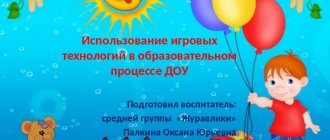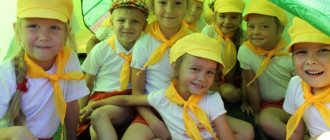“Innovative approaches in music education and development of preschool children”
Author: Kucher Lyudmila Petrovna
Musical director of MBDOU "DS" Solnyshko"
“Innovative approaches in music education and development of preschool children”
Innovative approaches in music education and development of preschool children.
“Music inspires the whole world,
supplies the soul with wings, promotes
flight of imagination; music gives life
and joy to everything that exists...
it can be called an incarnation
everything beautiful and everything sublime"
Music occupies a special, unique place in the education of preschool children. This is explained by the specifics of this type of art and the psychological characteristics of preschoolers. Music is called the “mirror of the human soul”, “emotional cognition” (B.M. Teplov), “model of human emotions” (V.V. Medushevsky): it reflects a person’s attitude to the whole world, to everything that happens around and in itself person. Primary musical education is designed to play a very important role in a person’s life.
The work of a music director in a preschool educational institution at the present stage is filled with new content - to raise a person capable of independent creative work, an active, searching person. Music is a source of special children’s joy, and the use of various pedagogical methods in music classes solves the most important task of early musical education - the formation of the leading component of musicality - the development of emotional responsiveness to music. When carrying out GCD, children develop the ability to perceive, feel, understand the beauty in life, art, and become involved in artistic and creative life. Therefore, I consider the goal of my work to be to ensure that every child develops musical communication and creative abilities, and strengthens mental and physical health.
Changing life around us dictates that modern teachers need to choose more effective means of teaching and education based on modern methods and new integrated technologies.
The use of innovative methods, forms and technologies in music education under the conditions of the introduction of the Federal State Educational Standard became the goal of my work.
I implement the goal in tasks that meet the urgent needs of the child:
- creating conditions that provide opportunities for each child to demonstrate their individual abilities when communicating with music;
- creative development of the child’s natural musicality;
- creating conditions for spontaneous creative manifestations.
The main principle that guides my work is attention to each child: taking into account his age, speech, individual musical characteristics and needs. There are a number of other principles that I adhere to in music classes:
- The musical director is an equal partner. He knows how to play interestingly and show creativity.
- Gives children the right to choose a musical repertoire, knowledge, skills,
- Focuses on the individual capabilities and abilities of children.
Integrated musical activity becomes the norm of musical life in kindergarten, as in my work. The purpose of this type is to give children an idea of the specifics of various types of art (music, painting, theater, choreography, poetry), the expressive features of their artistic means, the ability to convey thoughts and moods in different types of artistic activity of children in their original language.
The success of work on the musical development and education of children is impossible without the joint work of the music director and educators, whose work is aimed primarily at preserving the health of children. Health preservation is becoming a priority in the work of our preschool educational institution and many others. Science has proven that musical development is inextricably linked with the physical well-being of a child. Singing develops the vocal apparatus, speech, strengthens the vocal cords, and regulates children's breathing. Rhythm improves a child’s posture, coordination, confidence and plasticity of movements. Playing instruments develops a sense of rhythm, the ability to play alone and in an ensemble. All types of GCD contribute to solving the following problems:
- Preservation and promotion of children's health;
- Development of sensory and motor functions.
- Formation of the need for physical activity;
- Acquiring the skill of proper breathing;
5.Development of intellectual functions (thinking, memory, imagination, attention, perception, spatial orientation, etc.);
- Development of the emotional-volitional sphere and gaming activity;
- Formation of a harmonious personality.
Using the computer allows me to enliven joint educational activities with children. Computer techologies
expand the opportunity to present musical and didactic material provided for in the educational program of a preschool institution.
Using ICT
In musical educational activities, in my opinion, the cognitive interest of preschoolers in music began to intensify, children's attention intensified, as new motives for mastering the proposed material appeared, children became more active in the joint discussion of a musical work. Musical activity has become more meaningful, harmonious and productive.
The basis of innovative technologies for musical education of children is collective activity, combining: singing, rhythmic speech, playing children's musical instruments, dancing, improvised movement to music, voicing poems and fairy tales, pantomime, improvised theatrical performance.
The forms of musicality development that I use in practice are:
Communicative dances.
Involving a child in the process of playing music lies through creating an atmosphere of acceptance of each other and emotional and mental emancipation. Here, communicative dances are indispensable assistants, the use of which solves the following problems:
- development of communication skills,
- working on the sense of form,
- development of motor coordination,
- developing a sense of rhythm.
Finger games (musical and speech).
The value of finger games in the context of the development of children's musicality lies in the fact that they represent the first experiences of performing artistry. Finger games:
- develop the muscular system, fine motor skills, tactile sensitivity;
- increase the overall level of organization of the child;
- are aimed at developing a sense of rhythm, expressive speech intonation, and coordination of movements.
Rhythmic recitation to music
– synthesis of music and poetry. It can be defined as a musical pedagogical model in which the text can be sung and rhythmically recited. For example, the poem “April” by S. Marshak.
Carl Orff technique
opens up a wonderful world of sounds for children: the music of rain, sun, wind, icicles, snowflakes. Children develop skills of improvisation, imagination, and independent creativity. The educational activities I conducted on the topic “Autumn Mood”, “Winter Fantasy”, “Journey to the Spring Forest” contributed to the development of a sense of rhythm, creativity in playing musical instruments and free dancing, and to hear the “music of nature” through the perception of music.
Design method
The modern method of integrating activities allows you to solve a set of problems subordinated to one topic. The method is relevant and very effective. It gives the child the opportunity to synthesize acquired knowledge, develop creativity and communication skills. In addition, project-based activities allow children to develop research skills and cognitive interest.
Theme of patriotism
is relevant and significant in the work of our kindergarten.
I pay special attention to this topic, because it teaches children kindness, generosity, love for their Motherland and native land, respect for their parents and each other. Children participate in festive and folklore events, learn a lot about folk traditions: “ Old people, young at heart
”;
«My land is northern Yamal";
“In the friendship of the Nars is the unity of Russia”;
“ Warmth
of hearts for beloved mothers”;
“ Tsvetik - seven-colored” - Family Day and others.
The innovative technologies that I use in my work are focused on the full development of the child as an individual, on the desire to help him enter the modern world and join its values. An analysis of the work shows that the method of integration and variability in the use of innovative programs and technologies makes it possible to increase the level of musical development of children.

